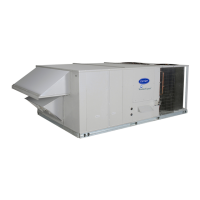
Do you have a question about the Carrier 50TC*17 Series and is the answer not in the manual?
| Brand | Carrier |
|---|---|
| Model | 50TC*17 Series |
| Category | Air Conditioner |
| Language | English |
Illustrates general unit arrangement and identifies key access locations.
Lists essential maintenance tasks for regular inspection and service.
Outlines checks required at the beginning of each season for optimal performance.
Procedure for removing and replacing return air filters.
Instructions for cleaning the outdoor air hood inlet screens.
Details on the location and cleaning of the economizer inlet air screen.
Description of the supply fan system, including vertical and horizontal models.
Details on how the SAV system adjusts fan speed for ventilation, cooling, and heating.
Criteria for identifying if the unit is equipped with the VFD option.
Notes on unit installation requirements when the SAV option is present.
Procedures and considerations for motor replacement.
Description of the condenser coil's construction and materials.
Essential steps for maintaining and cleaning condenser coil surfaces.
Methods for removing surface fibers and dirt from coil surfaces.
Benefits and procedure for rinsing coils with low-velocity water.
Detailed procedure for routine cleaning using approved coil cleaner.
Procedures for maintaining evaporator coil surfaces for longevity.
Methods for removing surface fibers and dirt from coil surfaces.
Benefits and procedure for rinsing coils with low-velocity water.
Detailed procedure for routine cleaning using approved coil cleaner.
Recommended equipment for applying the coil cleaner solution.
Step-by-step instructions for applying the environmentally sound coil cleaner.
Description of fixed-bore metering devices and troubleshooting for blockages.
Information on the location and function of refrigerant system access ports.
Explanation of Normal Cooling, Reheat1 (Subcooling), and Reheat2 (Hot Gas Reheat) modes.
Overview of the components that make up the Humidi-MiZer system.
Description of the three sub-modes of operation for the Humidi-MiZer system.
Explanation of how the TXV functions to regulate refrigerant flow.
Step-by-step procedure for replacing the thermostatic expansion valve.
Information on the location and function of refrigerant system access ports.
Procedures for checking and adjusting the refrigerant charge.
Standard evacuating techniques and leak testing procedures.
Guidance on charging units using specific charging charts and superheat.
Instructions on how to use the cooling charging charts for proper refrigerant adjustment.
Information on the type and amount of oil used in the compressor.
Steps for replacing the compressor, including POE oil considerations.
Periodic inspection of compressor mounting bolt tightness.
Procedure to determine and correct compressor rotation direction.
Guidance on replacing the filter drier whenever the refrigerant system is exposed.
Details on field installation of a general-purpose 125-volt circuit.
Description of the factory-installed transformer for unit-powered outlets.
Instructions for installing the weatherproof cover for GFCI receptacles.
Limitations and guidelines for the duty cycle of unit-powered outlets.
Procedure for installing the weatherproof while-in-use cover for outlets.
Overview of the smoke detector system, including controller and sensors.
Description of the smoke detector controller housing, PCB, and cover.
Details on the smoke detector sensor, including its housing and LEDs.
Information on sensor placement for supply air and return air configurations.
Description of the supply air smoke detector sensor location and access.
Location of the return air detector sampling tube without an economizer.
Location of the return air detector sampling tube when an economizer is present.
Wiring and operational response of the FIOP smoke detector.
How smoke detector signals integrate with PremierLink and RTU-Open controls.
Details on overcurrent, overtemperature, and high/low pressure protection for compressors.
Information on the low pressure switch for system protection.
Details on the overcurrent protection devices for the supply fan motor.
Information on the internal overtemperature protection for the condenser fan motor.
Details on the circuit breaker protecting the 24-V control circuit.
Guidance on installing sensors and accessories for the RTU-OPEN system.
Resources for further installation and troubleshooting of RTU-OPEN controls.
Information on standard sensors used with the EconoMi$er IV system.
Explanation of different control modes available for the EconoMi$er IV.
How the system uses outdoor dry bulb temperature for changeover control.
Using differential dry bulb sensors for enhanced control.
Utilizing outdoor enthalpy for changeover control.
Using DCV for ventilation control based on CO2 or occupancy.
Steps for configuring the CO2 sensor for demand control ventilation.
Procedure for checking differential enthalpy control.
How to check and set DCV minimum and maximum damper positions.
Procedure for checking the supply-air sensor input.
Procedure to return the EconoMi$er IV to normal operation after testing.
Steps to follow for pre-start-up inspections and preparations.
General unit preparation and important start-up sequence considerations.
Inspection of field-installed accessories and initial control insights.
Specific start-up procedures for PremierLink controls.
Specific start-up procedures for RTU-Open controls.
Detailed physical data for vertical unit configurations.
Continued physical data for vertical unit configurations.
Continued physical data for vertical unit configurations.
Detailed physical data for horizontal unit configurations.
Continued physical data for horizontal unit configurations.
Continued physical data for horizontal unit configurations.
Fan performance data for 15-ton vertical units.
Fan performance data for 17.5-ton vertical units.
Fan performance data for 25-ton vertical units.
Fan performance data for 27.5-ton vertical units.
Fan performance data for 15-ton horizontal units.
Fan performance data for 17.5-ton horizontal units.
Fan performance data for 20-ton horizontal units.
Fan performance data for 25-ton horizontal units.
Table listing part numbers for various wiring diagrams.
Control wiring diagram for 50TC units with 208/230V and 460/575V.
Control wiring diagram for 50TC D30 units with 208/230V.
Power wiring diagram for 50TC units with Humidi-MiZer and 208/230V.
Power wiring diagram for 50TC units with Humidi-MiZer and 460V.
Power wiring diagram for 50TC units with Humidi-MiZer and 575V.
Wiring diagram for the PremierLink system control.
Wiring diagram for the RTU-Open control system.
Wiring diagram for the SAV-VFD system control.
Illustrates sensor locations for D17, D20, and D24 models.
Illustrates sensor location for the D28 model.
Fields for model, serial number, date, and technician.
Pre-start-up verification tasks to be checked before unit operation.
Essential electrical, temperature, pressure, and general checks during unit start-up.
